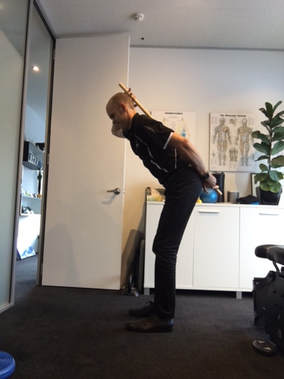
An alternative approach is to keep your back straight when you bend forward and try to look more like a table. This type of bending is called a ‘hip hinge’ and is one of the best spine sparring movements you can do (in other words it will help protect you from injury). In this post I will show you how to do the 'hip hinge' using a stick as a guide.
When you hip hinge, your spine stays in neutral position and the movement occurs through the hip joints which are designed to take this load.
A couple of key points from Professor McGill when looking at bending and back injuries.
- What matters is the number of bends, the time spent in the bent posture and the load being lifted. In other words, a few bends here and there is okay (our backs are designed to be able to bend), just don’t be bent like a cashew for long periods. This is important when you are simply bending forward, but even more important when bending forward whilst lifting things.
- Disc bulges occur after repetitive bending and loading of the back has caused de-lamination or disc injury. Our spinal discs are made up of a gel center and fibrous layers on the outside. Repetitive poor bending and moving can cause the layers to separate or loosen (de-laminate) which allows the gel center to migrate towards the outside. As it nears the outer edge it can create a bulge which can cause nerve irritation. The key thing is that scans do not always show early disc problems, only when the gel center has neared the edge. Therefore you can have a scan that appears normal, but there may be underlying disc problems. For more information on this, read an older blog post I wrote on spinal discs here.
- If there is underlying disc problems, then you may be more susceptible to bending such that pain is easily triggered. If there is an underlying problem, it ends up taking less and less to aggravate it, hence where once you could bend a certain way for a long period of time suddenly starts to cause pain after a short period. This is often due to the fact that there are no nerves in the middle of the disc, just in the very outer layers. Once those nerves are irritated, they can start to work their way towards the center of the disc meaning less and less aggravation is required before pain is felt.
- You can regain pain-free movement, build capacity for this pain-free movement by using this hip hinge. If you look after your back, and protect it with things like this hip-hinge, you can regain pain free movement. If you took the next step and strengthened your back appropriately, then you hopefully reduce the risk of future problems.
- If you have back pain and your scans are clear, you could still get the relief you want by understanding what is happening in your back and the mechanism of the pain. Just because your scans are normal, doesn't mean everything is functioning well. If you can learn how to move better, strengthen your back and make sure it is structurally working well, there is a good chance you can get the relief you want.
How to do the Hip-hinge with a stick
- Start with a strong athletic base, feet hip width apart and a slight bend in your knees. Stand in a good neutral posture with a slight curve in your lower back. Then brace your core.
- Using a stick that is placed on your back, touching the pelvis, upper back and head, is a great way to practice the movement to make sure you are not cheating. (see the picture below)
- The key movement to start with is to push your hips and hamstrings as far back as you can. You should feel your weight shift to your heels. Your knees should have a bend in them and stay over the heels.
- As you move your hips backwards start to ‘hinge’ forward from the hips, maintaining the slight curve in your lower back.
- Hinge forward as far as you can, maintaining good form. If you are using a stick, the three points of contact should stay touching throughout the movement. If you lose contact, your technique is not right.
- Once you have hinged forward as far as you can, push your hips forward and stand up, squeezing your glutes at the top of the movement. Then repeat.
How far your move safely will depend on your flexibility, joint function etc. If you struggle with this movement, please ask for some advice. Often people need to do a lot of stretching and soft tissue work to get full motion with good technique, but the results are well worth the effort.
References
Back fit pro instagram page - https://www.instagram.com/backfitpro/
https://www.npr.org/sections/health-shots/2018/02/26/587735283/lost-art-of-bending-over-how-other-cultures-spare-their-spines




 RSS Feed
RSS Feed


